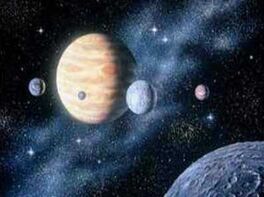UnNews:Kepler discovers boodles of exoplanets
| UnFair and UnBalanced | ✪ | UnNews | ✪ | Monday, January 12, 2026, 01:15:59 (UTC) |
| Kepler discovers boodles of exoplanets | 
|
11 May 2016
CAPE CANAVERAL, Florida -- Scientists at NASA have announced the existence of a record 1,284 planets outside the solar system. The so-called exoplanets were identified by the Kepler space telescope. Its mission ended in 2013, though the news was embargoed to fill a lean week in election-year news.
NASA scientists, laboring to explain the utility of their discovery, stated that a whopping 9 exoplanets are at the right distance from their sun that water could exist in liquid form, raising hopes of lakefront summer homes, golf courses with water hazards, and — most promising of all — alien life that is just like us. NASA asserted that its count of planets was "99% accurate," though it did not provide an estimate of how accurate the 99% figure was.
These life forms, judging from human history, could instantly become a food source, game animal, or indentured servants, depending on their skin color. Or, if the aliens got the upper hand, the human race could perform those functions for them. Or, given the Obama administration's notorious "re-purposing" of NASA as an instrument of Outreach to Muslims, the little green men could become the newest audience for apologies about the blemishes on America's history. Many others in Congress wrestle daily with the fact that they cannot legislate schemes of "universal coverage" without taking them to the universe.
The announcement of the 1,284 exoplanets was timed to coincide with the rare transit of Mercury across the face of the sun (from Earth's point-of-view). NASA presumed that this would get people thinking about astronomy again — especially in a week when the alternative was to try to make some sense of Hillary versus Trump. Mercury appeared as a spectacular pinprick against the disc of the sun. Princeton University astronomer Tim Horton watched the entire transit and developed the technique of extrapolating the existence of exoplanets — his final scientific discovery, as he will be filing for Permanent Disability due to the sudden and tragic onset of total blindness.
NASA said the nearest planetary Shangri-La is very close — reachable in only 11 years at Warp Factor 1, from the astronauts' point-of-view, though Relativity suggests that the human race would have evolved into something else entirely by the time they got back. Pressed on why any taxpayer would want to pay for this research, Horton said that it would lead to a new space race, followed by a new arms race, in which both we and the Damned Soviets would try to be the first to put nuclear weapons on the resort exoplanet, leading to another World War in which each nuclear exchange takes 11 years, leaving plenty of time for analysis and commentary between them. Horton said that it is part of humanity's eternal quest for knowledge, and inherently more important than knowing why the jobs market went to Hell after we slapped another 3.8% tax on investment.
Sources[edit]
- Reuters "Record 1,284 planets added to list of worlds beyond solar system". Times of India Times, May 11, 2016
